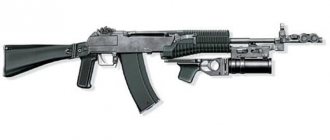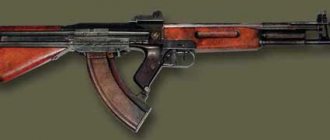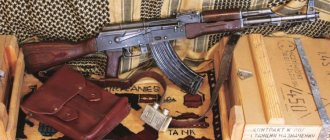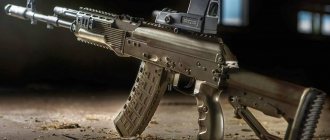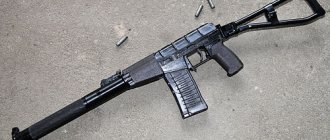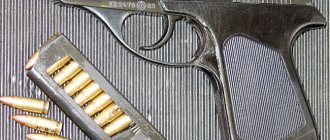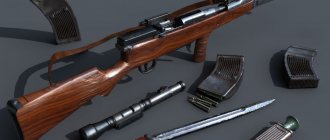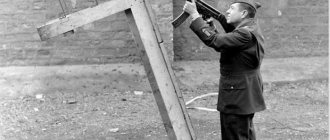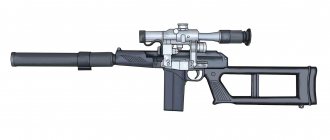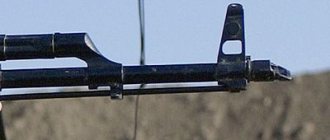Special forces weapons
Automatic A-91
Automatic A-91
Caliber:
7.62x39mm or 5.56x45mm NATO
Automation type:
gas vent, locking by turning the bolt
Length:
660 mm
Barrel length:
415 mm
Weight:
3.97 kg without magazine
Rate of fire:
600-800 rounds per minute
Shop:
30 rounds
A-91 automatic grenade launcher system
(sometimes the designation A-91M is also found) was developed at the Tula Instrument Design Bureau (KBP) under the leadership of the famous weapons designer V.P. Gryazev. This model was originally intended for arming the special operations forces of the army and the Ministry of Internal Affairs of Russia, as well as for export. The weapon is created in a bullpup configuration, with a 40mm grenade launcher integrated into the design.
During development, the configuration and appearance of the weapon changed several times, the most noticeable change was the location of the 40mm GP-95 grenade launcher - if on early samples it was located above the barrel of the weapon, in front of the carrying handle, and in front under the barrel there was an additional vertical handle for holding the weapon, then in the latest version, the grenade launcher has moved to a more traditional place, under the barrel of the weapon, and its casing forms the forend. When creating the A-91, the developers decided to get rid of the main problems associated with the bullpup layout - the ejection of spent cartridges near the shooter's face when firing from the left shoulder, and the center of gravity shifted to the rear of the weapon.
The second problem was solved by simply installing a massive grenade launcher in the front of the weapon, and to solve the first problem, a scheme was developed to remove the cartridges from the receiver forward, through a special channel running along the breech of the barrel and leading the cartridges out to the right, just behind the pistol grip. A partly similar idea was implemented in the Belgian FN F2000 assault rifle, but for the first time a similar scheme was implemented in the experimental Korobov and Afanasyev assault rifles, created in the USSR back in the 1960s.
The receiver, which does not have a window for ejecting spent cartridges, made it possible not only to protect the weapon’s mechanisms from dirt, but also to reduce gas contamination in the area of the shooter’s face, thereby increasing the comfort of shooting.
Currently, the A-91 assault rifle
The KPB is advertised as a promising weapon, but there is no data on serial production and purchases of this model in open sources. In general, it is surprising that there is no detailed information about this undoubtedly interesting specimen in open sources, both Russian and foreign.
Automatic A-91
built on the basis of traditional automation with a gas exhaust circuit and locking the barrel bore by turning the bolt. Spent cartridges are ejected forward, on the right side of the weapon above the pistol grip, through a special channel running along the barrel. The charging handle is located on top, under the handle for carrying the weapon, and is equally accessible for both hands.
Fire modes - single shots and bursts. The fire mode switch (it also acts as a fuse) is located on the right side of the receiver, in its rear part, and is similar in design to that on Kalashnikov assault rifles. The machine gun has two triggers - the front one controls the integral 40mm grenade launcher, the rear one controls the machine gun itself. In this case, the rear (automatic) trigger has an additional automatic safety device against accidental shots, similar to the Glock or GSh-18 pistols. The grenade launcher is an integral component of the machine gun.
Sights include a rear sight built into the carrying handle and a high-mounted front sight mounted on the barrel. Additionally, a folding sight for a 40mm grenade launcher is located on the front of the barrel. The upper part of the carrying handle is made in the form of a Picatinny rail, and allows you to install various types of optical and night sights on it.
Incomplete disassembly of the booms of the A-91M (7.62 mm) fork-grenade launcher system
A sector sight with a diopter rear sight and an adjustment drum is mounted on a carrying handle. The use of a diopter made it possible to lengthen the aiming line.
A 40-mm muzzle-loading grenade launcher is integrated into the forend of the machine gun. Installing a grenade launcher improves the balance of a bullpup weapon, which is important when shooting without a rest. The weapon has two separate triggers for the machine gun and for the grenade launcher. The grenade launcher sight is mounted on the left side of the body. The rubber butt pad softens recoil when firing from a grenade launcher.
The A-91M modification chambered for 5.56×45 cartridges was created as an export version. The main difference lies in the design of the barrel, rotating bolt and magazine (with a plastic body), but a number of other parts and assemblies have also been changed - in particular, the gas piston rod and sector sight. The target firing range is up to 500 m. The grenade launcher assembly can be replaced with a conventional forend assembly.
See also on Spetsnaz.org:
- Nikonov AN-94 assault rifle (Abakan)
- Kalashnikov AK-12 assault rifle
- Automatic A-91
- SR-3, SR-3M "Whirlwind"
- Kalashnikov AK-9 assault rifle
The purpose of the machine
Automatic 9A-91 with silencer
Gryazev’s assault rifle meets the needs of the National Guard and special police forces. They manage to effectively knock out terrorists and other especially dangerous armed criminals, eliminate enemy personnel, including suppressing firing points during army special operations.
True, there are critical reviews about weapons. According to their authors:
- The 9A-91 is not silent - the shot and the clanging shutter are heard too well;
- The performance characteristics leave much to be desired, namely, the product’s weight is relatively large and its accuracy is low;
- The quality of ammunition produced specifically for the 9A-91 is inferior to other cartridges.
Nevertheless, the weapon is quite reliable for special police forces and members of the National Guard, inexpensive and quite suitable for eliminating criminal elements in the city. So Gryazev’s brainchild deservedly remains in demand. At the same time, using it in extreme conditions, where special forces often find themselves, is risky.
Partial and complete disassembly of the machine during maintenance
Every firearm needs a thorough cleaning after every shooting session.
The procedure for partial disassembly of the AKS-74U is carried out to clean, lubricate and inspect the general condition of the machine’s mechanisms. This operation is performed in a strictly defined order:
- The equipped magazine is separated;
- The bolt is jerked to make sure that there is no cartridge in the barrel;
- The flame arrester is removed;
- The receiver cover opens;
- The return mechanism and bolt frame are separated;
- The frame and shutter are separated;
- The gas tube is disconnected from the receiver lining.
This completes the process of incomplete disassembly. It is recommended to completely disassemble the AKS-74U mechanisms only during repairs or when they are heavily soiled. Complete disassembly of the machine:
- The magazine, bolt, return and firing mechanism are disassembled;
- The forend is separated.
The machine is assembled in the reverse order. After each shooting, the machine gun must be cleaned using gun lubricant and a solution for cleaning barrels from carbon deposits. Before long-term storage, AKS-74U is covered with a special liquid solution and wrapped in inhibited and waxed paper.
What is proposed to replace “shortening”?
In the mid-1990s, it was proposed to replace the Ksyukha with new AK-105.
In 1994, a new AK-105 assault rifle was created, intended to replace the AKS-74U. This model is capable of more effective fire at long distances due to the increased barrel length. The AK-105 is 94 mm longer, but its ballistic characteristics have increased. The heating of the barrel decreased, the butt and fore-end began to be made of black glass-filled polyamide. Firing devices, thrust rings, gas piston, swivel and some other metal parts are made by precision casting. A special coating is used to protect against corrosion. The AK 105 series sighting bar has a range of up to 500 m, which complies with the NATO standard.
New short machines are now in use:
- Private security;
- FSSP RF;
- FSUE "Security" of the Ministry of Internal Affairs of the Russian Federation.
“Ksyukha” is still the most popular short machine gun of law enforcement agencies in Russia and the CIS countries. Over the past decades, weapons have repeatedly proven their effectiveness in urban environments. In the future, the prospect of re-equipping the Ministry of Internal Affairs employees with submachine guns created on the basis of the AKS-74U is being considered.
Author of the article:
ULFHED
I am interested in martial arts with weapons and historical fencing. I write about weapons and military equipment because it is interesting and familiar to me. I often learn a lot of new things and want to share these facts with people who are interested in military issues.
Machine modifications
Modification of the 9A-91 assault rifle with a bracket for equipping with various detachable sights
The first modification 9A-91 is distinguished by the presence of a compensator and an updated fuse-translator located on the left.
When creating the next variation, the design team removed the compensator, made the fuse-translator smaller, and added the option of installing a muffler.
The design of the third modification, dated 1995, in addition to the silencer, includes a bracket for mounting various removable sights. Adding the bracket forced the translator flag to be moved to the right. From a machine gun with optics, you can conduct covert shooting to hit objects located at a distance of up to 400 meters.
If a standard machine gun has only an open sight, designed for a range of 100 and 200 m, then the upgraded version can be equipped with sights:
The fourth variation is devoid of a bracket and is equipped with an enlarged forend.
Based on the Gryazev assault rifle, a silent VSK-94 sniper rifle was designed with a non-folding stock, a stationary silencer and an improved bracket for detachable sights. It was adopted by the same Russian security forces as the 9A-91.
There are modifications of the 9A-91 of reduced caliber for various NATO-style cartridges, created for export. But they did not go into mass production, presumably due to test results that showed them to be uncompetitive.
According to data citing unofficial sources, today the development of weapon variations for intermediate warheads of Russian and NATO standards continues. This is quite likely, however, whether this information is true is unknown.
There is information about attempts to create an assault rifle, the design of which will include an under-barrel grenade launcher. But they failed because the weight and strength of the original product were unable to withstand the recoil of grenades.
What opinion did you have about this weapon after reading the article? Perhaps you are familiar with the reviews of soldiers who use the 9A-91 automatic compact due to their profession? Maybe you have shot it yourself and know what it is, can you share some “insider” information? We will be grateful for your comment, we will be happy to answer interesting questions that arise while reading the article, we are always happy to receive feedback from you, dear readers!
If you have any questions, leave them in the comments below the article. We or our visitors will be happy to answer them Source
Ammunition for 9A-91
The original 9A-91, unlike some modifications, can be loaded with three types of warheads:
- SP-5;
- SP-6;
- PAB-9.
The third of the listed cartridges was designed on the initiative of the leaders of the Ministry of Internal Affairs of the Russian Federation, who saw the need to create cheaper ammunition than those developed at the Central Research Institute of TOCHMASH. Both SP charges seemed too expensive because a special range of metals and alloys were used in their production. Users have complaints about the ballistic properties of SP-5 and 6.
The design feature of PAB-9 is a heat-strengthened steel core. Despite its existing shortcomings, it successfully defeats militants, penetrating armor armor.
Design 9A-91
Disassembled 9A-91
The operation of the machine is based on automatic gas release and rotary bolt locking of the barrel. The trigger trigger allows you to fire in bursts or single shots.
The first 9A-91 was produced with a muzzle compensator, further modifications were without.
The fuse is placed on the left side of the machine in the initial models, on the right - in the modified ones, with a mount located on the left for an additional sight.
The steel folding stock is retracted with an up-and-forward movement onto the barrel box cover. The cocking handle can also be folded, making the 9A-91 compact and allowing for concealed carry.
The pistol grip and forend are made of durable polymer material, other elements are made of steel, by spot welding and stamping.
The standard sight is open, allowing precise shooting at a distance of up to 200 meters.
The magazine is straight, double-row, with a latch located in front of the trigger guard.
